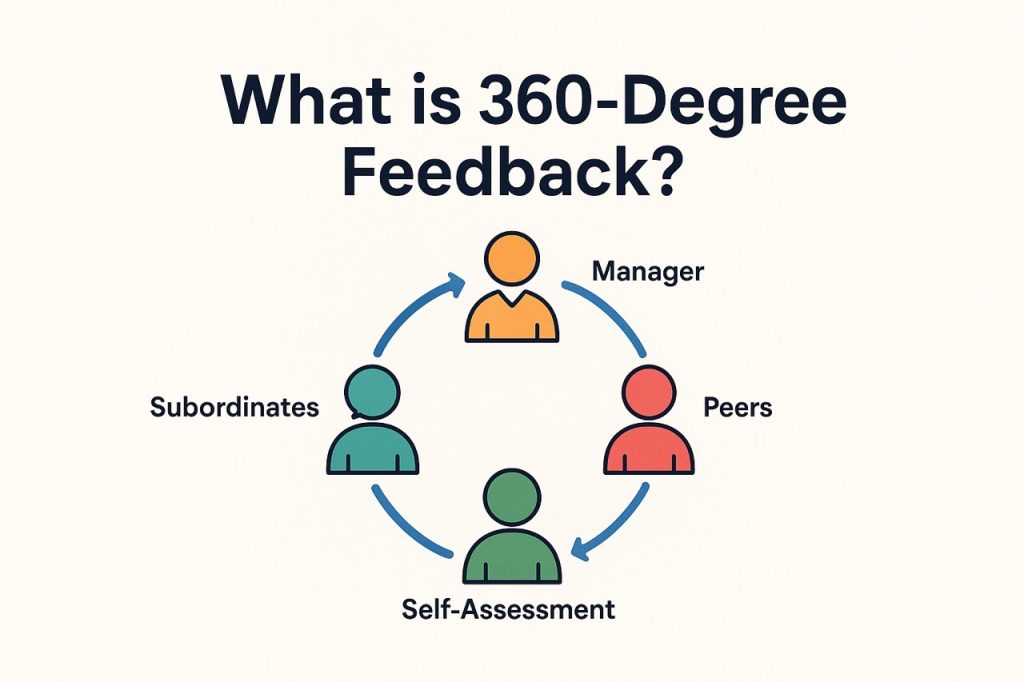What is 360-Degree Feedback? Benefits, Use Cases & How It Works

In today’s dynamic workplace, feedback is no longer a once-a-year top-down event. It’s continuous, collaborative, and—when done right—empowering. One of the most powerful tools organizations use to support this culture of growth is 360-degree feedback.
But what exactly is 360-degree feedback? How does it work? And why are more companies—including schools, startups, and enterprises—adopting it? Let’s break it down.
What is 360-Degree Feedback?
360-degree feedback, also known as multi-rater feedback, is a performance evaluation method where an employee receives confidential feedback from people they work with—managers, peers, subordinates, and even customers or clients.
It contrasts with the traditional one-way performance review, where only a direct supervisor evaluates the employee. Instead, the goal is to create a holistic view of someone’s strengths and areas for improvement based on multiple perspectives.
Feedback is often gathered via standardized questionnaires or digital forms with both quantitative scores and open-ended questions. This multi-source approach leads to more objective, accurate, and actionable insights.
Key Components of 360-Degree Feedback
The 360-degree feedback process typically includes:
- Self-assessment: The individual evaluates their own performance.
- Peer feedback: Colleagues who work closely with the person provide input.
- Manager feedback: The person’s direct supervisor shares observations.
- Subordinate feedback: If the person leads a team, direct reports contribute feedback.
- External feedback (optional): Clients or partners may be included when relevant.
All of this input is compiled into a report that highlights trends, gaps, and opportunities for growth.
Why 360-Degree Feedback is Valuable
Let’s look at some of the benefits that make 360-degree feedback a popular tool for modern organizations:
1. It Provides a Balanced Perspective
Feedback from just one source can be biased or incomplete. By collecting data from multiple people who interact with the individual in different ways, 360-degree feedback offers a more comprehensive picture.
2. It Promotes Self-Awareness
When employees compare their self-perception with how others view them, they gain valuable insights. This helps uncover hidden strengths and blind spots that may be holding them back.
3. It Encourages Personal and Professional Growth
The feedback becomes a springboard for development. Employees are more likely to take ownership of their improvement when they see consistent patterns in the feedback.
4. It Strengthens Team Communication
Because 360-degree feedback fosters open dialogue, it contributes to building a culture of trust, collaboration, and continuous improvement.
5. It Supports Leadership Development
Many leadership programs use 360-degree feedback to help leaders understand how their behavior impacts others, an essential skill for managing teams effectively.
Use Cases: Where 360-Degree Feedback Makes a Difference
360-degree feedback isn’t limited to annual reviews. Here are some real-world examples of how organizations use it:
✅ Performance Reviews with Depth
Add 360-degree feedback to your performance management process to move beyond simple metrics and create a narrative around performance.
✅ Leadership Development Programs
Coach future leaders by providing feedback from team members, peers, and upper management, helping them understand their influence and improve interpersonal skills.
✅ Team Effectiveness Initiatives
Assess how well team members collaborate, communicate, and contribute to shared goals.
✅ Conflict Resolution
Use feedback from various perspectives to understand interpersonal issues and resolve them constructively.
✅ Onboarding Check-ins
After the first few months, 360 feedback helps new hires understand how they’re perceived and integrate better with teams.
Example Scenario: Using 360-Degree Feedback in a School
Let’s say a school wants to evaluate its teachers in a more modern and inclusive way.
- Students could provide feedback on clarity, engagement, and accessibility.
- Other teachers might share input on collaboration, knowledge sharing, and support.
- The principal would assess professionalism, classroom results, and alignment with school goals.
- The teacher themself could reflect on their growth and goals.
The result? A rounded, honest, and actionable view of how the teacher is performing, not just from one observer, but from those impacted daily.
This approach can improve teacher effectiveness, student engagement, and overall school culture.
Challenges to Watch For
While powerful, 360-degree feedback isn’t without challenges. Poorly implemented systems can create confusion, anxiety, or even resentment. To be effective:
- Ensure anonymity so people feel safe giving honest feedback.
- Use clear and structured questions aligned with specific competencies.
- Provide context and coaching when sharing results to avoid misinterpretation.
- Make sure feedback is constructive and balanced, not overly critical or vague.
When designed well, the process builds trust, not fear.
How Atwork Helps You Run 360-Degree Feedback Smoothly
Atwork makes it simple to implement 360-degree feedback across your organization, whether you’re a startup, agency, school, or enterprise team.
With Atwork’s evaluation tools, you can:
- Build custom feedback forms with ratings and open-ended questions
- Automatically assign reviewers from different roles (managers, peers, etc.)
- Protect anonymity to encourage honest input
- Set review cycles and automated reminders
- View insightful reports with visual breakdowns
- Track changes and progress over time
All without needing spreadsheets or third-party tools.
360-degree feedback becomes more than a process—it becomes a core part of your performance culture.
Final Thoughts
360-degree feedback gives people the insights they need to grow, not just from one angle, but from all directions. When implemented thoughtfully, it helps individuals become better teammates, stronger leaders, and more self-aware professionals.
As more organizations shift toward people-centric performance management, tools like Atwork make it easy to bring this powerful method to life efficiently, thoughtfully, and at scale.
🔜 Coming Next…
In our next article, we’ll explore how to design and run a 360-degree feedback system inside Atwork—including form templates, question design, scoring, and automation.
Stay tuned!